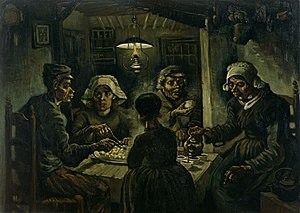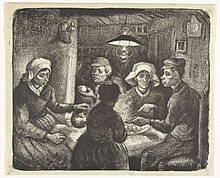The potato eaters

|
| The potato eaters |
|---|
| Vincent van Gogh , 1885 |
| Oil on canvas |
| 81.5 × 114.5 cm |
| Van Gogh Museum |
The Potato Eaters ( Dutch De Aardappeleters ) is a painting by Vincent van Gogh that he painted in Nuenen in April 1885 .
The painting measures 81.5 × 114.5 cm and is painted with oil paints on canvas.
description
The Potato Eater is Van Gogh's first great work, on which he worked for a few months. The two oil paintings were created between April 13th and the beginning of May.
Peasants seated at supper are depicted. Van Gogh, who also tried himself as a preacher for a short time, wanted to express man's relationship to nature and to the work of his hands. On April 30, 1885, he wrote in letter 404 to his brother Theo:
“I would have loved to send you the picture of the potato eaters that day, but although things are going well, it's not quite finished yet. Although I will have painted the actual picture in a relatively short time, and to a large extent from my head, it took a whole winter to paint study heads and hands. [...] I have tried very hard to make the viewer think that these people who eat potatoes by their lamp have dug up the earth themselves with the same hands that reach into the bowl; so the picture speaks of the work of their hands and that they honestly deserve their food. I wanted it to be a reminder of a completely different way of life than ours, that of the educated. I don't want everyone to think it's beautiful or good. "
The subject exists in two versions in oil, which were probably created in April 1885: The version shown above in the Van Gogh Museum in Amsterdam (F 82, JH 764, size 81.5 × 114.5 cm) and an earlier version in the Kröller- Müller Museum , Otterlo (F 78, JH 734, size 72 × 93 cm).
In addition, van Gogh brought out a cheap lithograph that appears reversed (the artist never bothered to reverse mirror images. For example, all of his self-portraits are mirrored).
Origin and Criticism
Almost 40 painted studies of heads, hands and other planned compositional elements show Van Gogh's meticulous preparation for the painting. A few days after the death of his father (who died of cardiac arrest on March 26, 1885) van Gogh began to paint the socially critical oil painting. It took him just three weeks to do this. He wanted to paint like Jean-François Millet and discovered his own painting style with the earthy tones. Rembrandt's "The Emmausmahl" is said to have served as a model.
Anthon van Rappard criticized the painting technique and denied van Gogh the successor to Millet.
swell
- Vincent van Gogh. All letters , ed. Fritz Erpel & trans. Eva Schumann. Henschel-Verlag, Berlin (GDR), volumes 1–4, 1965 & volumes 5–6, 1968, new edition: Lamuv Verlag, Frankfurt am Main, 1985
- Vincent van Gogh - letters, paintings, drawings , digital library CD-ROM, Directmedia Publishing, Berlin 2005, ISBN 3-89853-542-8
The “potato eaters” are mentioned in the following letters: 399, 402, 403, 404, 405, 408, 409, 418, 424 (Volume 3) 520, 533 (Volume 4) R57 letter to Amice Rappard, B15 letter to Émile Bernard (Volume 5), W1 letter to his sister Willemien (Volume 5, p. 35)
The following statement is testified by Willem van de Wakker:
"Vincent told Mr. van de Wakker the following about the creation of the picture" The Potato Eaters ": One evening, after he had been painting outdoors all day, he passed the house of the de Groot family, where he often worked, and came in to rest a little. The whole family was just having dinner under the lamp. Vincent spontaneously picked up canvas, brush and palette and began to paint the group. "
(All contained in the volumes of the Henschel edition and the CD-ROM of the Directmedia publishing house)
Web links
Individual evidence
- ↑ Zwikker, Roelie, Willemstein, Denise: Masterpieces in the Van Gogh Museum, Van Gogh Museum Enterprises BV, 2002, p. 26
- ↑ cf. Hans Kaufmann, Rita Wildegans: Van Gogh's ear. Paul Gauguin and the Pact of Silence. Berlin 2008, ISBN 978-3-940731-14-2 , p. 87
- ↑ cf. Hans Kaufmann, Rita Wildegans: Van Gogh's ear. Paul Gauguin and the Pact of Silence. Berlin 2008, ISBN 978-3-940731-14-2 , p. 87

